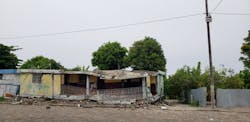After a devastating earthquake hit Haiti last week, EarthSpark International temporarily de-energized its 100-kW community microgrid in Les Anglais to check for downed wires and await possible aftershocks. Allison Archambault, president of the nonprofit organization, was terrified that EarthSpark wouldn’t be able to re-energize the microgrid if inspections revealed damage.
The 7.2 earthquake was so severe that it killed more than 2,200 people, destroyed an estimated 55,000 homes, and created strong quaking that reached more than one million people.
Given the magnitude of the destruction Archambault realized it would be difficult to repair the microgrid if its distribution system required specialized tools. Landslides had made roads impassable.
Fortunately for the residents of the town, the microgrid, consisting of solar, storage and diesel, did re-energize, providing power to a cell tower. The electricity helped residents quickly hold funerals for those who had died in the earthquake and whose bodies couldn’t be transported to morgues because of the blocked roads. And it allowed some of the microgrid’s 2,000 customers to celebrate Patron Saint Day with music and cold drinks.
Not only did the Les Anglais microgrid power through the Aug. 14 earthquake, but a 95-kW EarthSpark microgrid in Tiburon, a small fishing town in the southern peninsula of Haiti, also survived the earthquake. Also operating through the disaster was a microgrid served by the Cooperative Electrique de l’Arrondissement des Coteaux that provides power to 1,200 people in Coteaux, Roche-à-Bateaux and Port au Piment. It was installed by the National Rural Electric Cooperative Association (NRECA), said Kate Tillotson, a spokeswoman for NRECA.
“The power system we installed remained in operation with no visible damage,” she said.
EarthSpark raising funds for more DERs and microgrids in Haiti
For EarthSpark’s Archambault, Haiti’s latest crisis has sparked interest in adding distributed energy resources (DER) closer to critical services such as the cell tower. With such resources, the organization wouldn’t have to worry so much about losing power because of downed poles and wires.
“If we have more distributed energy, solar plus storage, throughout the grid, we’re less reliant on any piece of infrastructure,” she said. The organization is working to raise funds to add DERs to the microgrids.
According to EarthSpark, its microgrid in Tiburon had more than 380 connections by the end of the second quarter of 2020, and the company expects it to serve more than 500 houses and businesses over the next few years. Customers needed about 4,000 kWh in April 2020, a higher per capita consumption than the Les Anglais system, reflecting higher income levels in Tiburon.
EarthSpark added a new battery and system setup for the Les Anglais microgrid in 2019 — 208 kWh of storage — which allowed for 24/7 service.
The organization is also raising funds for proposed community microgrids in 22 towns located in the region hit by the earthquake. In this region, there is no grid power, but residents use diesel generators that would be replaced by renewable microgrids. The Green Climate Fund will provide $9.9 million toward the $45 million project, said Archambault. The nonprofit is working to raise the rest of the money.
EarthSpark has learned, through its microgrid work in Haiti, that the value of using diesel in the systems on the island is outweighed by the problems it causes, Archambault said.
“We will never use diesel again. We will do 100% solar and storage. Diesel is a small fraction of the energy and a large portion of the challenges,” she said. A major challenge is diesel shortages.
Need for basic necessities
Another key lesson for EarthSpark is that electricity is important for a country like Haiti, but even more important are basic necessities such as medical care and tarps to protect people sleeping in the rain during the tropical storm that followed the earthquake.
EarthSpark hopes to help with disaster readiness — including bolstering health clinics — in the other 22 towns where it will build microgrids.
“In addition to making sure we can power critical loads through natural disasters, we’re now reaching out to understand if we can also use our logistics, management and local teams to help support other aspects of disaster readiness in the 22 towns where we intend to expand,” said Archambault.
Sigora Haiti also operates in the country, and its assets include three microgrids in the towns of Môle-Saint-Nicolas, Jean Rabel and Presqu’île. A spokesperson noted that the private utility company serves more than 25,000 people in Haiti, but could not confirm whether the microgrids continued to operate after the earthquake.
Track news about microgrids powering through natural disasters. Subscribe to the free Microgrid Knowledge Newsletter.
About the Author
Lisa Cohn
Contributing Editor
I focus on the West Coast and Midwest. Email me at [email protected]
I’ve been writing about energy for more than 20 years, and my stories have appeared in EnergyBiz, SNL Financial, Mother Earth News, Natural Home Magazine, Horizon Air Magazine, Oregon Business, Open Spaces, the Portland Tribune, The Oregonian, Renewable Energy World, Windpower Monthly and other publications. I’m also a former stringer for the Platts/McGraw-Hill energy publications. I began my career covering energy and environment for The Cape Cod Times, where Elisa Wood also was a reporter. I’ve received numerous writing awards from national, regional and local organizations, including Pacific Northwest Writers Association, Willamette Writers, Associated Oregon Industries, and the Voice of Youth Advocates. I first became interested in energy as a student at Wesleyan University, Middletown, Connecticut, where I helped design and build a solar house.
Twitter: @LisaECohn
Linkedin: LisaEllenCohn
Facebook: Energy Efficiency Markets

